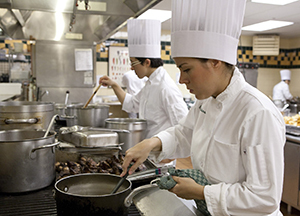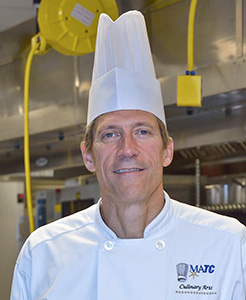 The BCA Global’s 21st-Annual Cultural Awareness Salute and Black Tie Gala will be held Nov. 21, 2014, at the Crowne Plaza Times Square Manhattan in New York City to honor the achievements of people of color in the industry.
The BCA Global’s 21st-Annual Cultural Awareness Salute and Black Tie Gala will be held Nov. 21, 2014, at the Crowne Plaza Times Square Manhattan in New York City to honor the achievements of people of color in the industry.
This year’s theme of “Crossing Cultures” will focus on a deeper understanding of global diversity in the foodservice, culinary and hospitality industries. The event will provide a space for networking and dialogue about the advancement of diversity and give culinary students from around the country the opportunity to hone their skills in a real-life environment.
The gala will begin with a VIP and cocktail reception, followed by a multi-course dinner and Viennese reception. The gala dinner will give a taste of what the future holds for the foodservice industry and will be supported by educational partners and students from Johnson & Wales University, South Bronx Job Corps Academy, the Culinary Program at Brooklyn Job Corps Academy, Career Academy of NY and LI, Culinary Training Institute, New York Institute of Technology, Fed Cap Culinary Training Program and The Culinary Institute of America.
Students from different schools and different backgrounds come together in the same kitchen and cook for the gala in a noncompetitive environment, say Howard Stanford, board chair, and Alex Askew, president, BCA Global.
BCA Global (founded as the Black Culinarian Alliance) is a nationwide nonprofit, educational and networking organization of hospitality and foodservice professionals. Incorporated as a 501(c)(3) in 1998, its mission is to create exposure and provide educational and professional opportunities for culinary and hospitality professionals of color. This objective is accomplished by providing quality educational and employment resources, job coaching, mentoring and assistance with placement, and networking support.
For more information on the 21st-Annual Cultural Awareness Salute and Black Tie Gala , e-mail This email address is being protected from spambots. You need JavaScript enabled to view it.or call (212) 643 -6570. For more information on BCA Global, visit www.bcaglobal.org.
 A successful, time-honored business in Northern California projects saving 65% of current energy usage thanks to a new solar-energy system it recently installed, helping to shape the future of the baking industry.
A successful, time-honored business in Northern California projects saving 65% of current energy usage thanks to a new solar-energy system it recently installed, helping to shape the future of the baking industry.
 The BCA Global’s 21st-Annual Cultural Awareness Salute and Black Tie Gala will be held Nov. 21, 2014, at the Crowne Plaza Times Square Manhattan in New York City to honor the achievements of people of color in the industry.
The BCA Global’s 21st-Annual Cultural Awareness Salute and Black Tie Gala will be held Nov. 21, 2014, at the Crowne Plaza Times Square Manhattan in New York City to honor the achievements of people of color in the industry. The
The  Entries in the 2014 Discover Duck Recipe Contest proved that the possibilities with duck are boundless. Concepts ranging from Latin-influenced entrées to decadent desserts and upscale state-fair favorites captured the attention of judges who awarded more than $19,000 in cash and prizes. Sponsored by Maple Leaf Farms, the annual contest challenged professional chefs and culinary students to produce original recipes showcasing Maple Leaf Farms duck. More than 260 recipes from across the country were submitted.
Entries in the 2014 Discover Duck Recipe Contest proved that the possibilities with duck are boundless. Concepts ranging from Latin-influenced entrées to decadent desserts and upscale state-fair favorites captured the attention of judges who awarded more than $19,000 in cash and prizes. Sponsored by Maple Leaf Farms, the annual contest challenged professional chefs and culinary students to produce original recipes showcasing Maple Leaf Farms duck. More than 260 recipes from across the country were submitted. The Culinary Institute of America and Half Moon Theatre, the Hudson Valley’s leading year-round professional theatre company, recently announced a new partnership that will bring New York-style theatrical performances to the Hyde Park campus. The CIA’s new 800-seat, state-of-the-art Ecolab Auditorium in the Marriott Pavilion makes it possible for visitors to enjoy a meal in either the The Bocuse Restaurant, American Bounty or Ristorante Caterina de’ Medici prior to experiencing one of Half Moon Theatre’s productions.
The Culinary Institute of America and Half Moon Theatre, the Hudson Valley’s leading year-round professional theatre company, recently announced a new partnership that will bring New York-style theatrical performances to the Hyde Park campus. The CIA’s new 800-seat, state-of-the-art Ecolab Auditorium in the Marriott Pavilion makes it possible for visitors to enjoy a meal in either the The Bocuse Restaurant, American Bounty or Ristorante Caterina de’ Medici prior to experiencing one of Half Moon Theatre’s productions. On its 80th anniversary, Kendall College’s president envisions a future in which everyone worldwide with a passion for food may pursue their dreams to cook professionally.
On its 80th anniversary, Kendall College’s president envisions a future in which everyone worldwide with a passion for food may pursue their dreams to cook professionally. A new degree is designed to prepare graduates to influence the future of food.
A new degree is designed to prepare graduates to influence the future of food. This second in a two-part series on teaching culinary arts through ratios in practical culinary labs focuses on incorporating ratios into your lesson plan.
This second in a two-part series on teaching culinary arts through ratios in practical culinary labs focuses on incorporating ratios into your lesson plan.